













2.8L
























































2.8L









































PUBLISHER
James R. Baker
GENERAL MANAGER
John Rusnak
EXECUTIVE EDITOR
Andy Walgamott
EDITOR
Chris Cocoles
CONTRIBUTORS
Mark Fong, Scott Haugen, Tiffany Haugen, Tim E. Hovey, Cal Kellogg, Meghan Snow
SALES MANAGER
Paul Yarnold
ACCOUNT EXECUTIVES
Janene Mukai, Tom St. Clair
DESIGNERS
Gabrielle Pangilinan, Lesley-Anne Slisko-Cooper
PRODUCTION ASSISTANT
Emily Baker
DIGITAL STRATEGIST
Jon Hines
ADMINISTRATIVE ASSISTANT
Katie Aumann
INFORMATION SERVICES MANAGER
Lois Sanborn
Volume 16 • Issue 9
ADVERTISING INQUIRIES ads@calsportsmanmag.com
CORRESPONDENCE
Email ccocoles@media-inc.com
X @CalSportsMan Facebook.com/californiasportsmanmagazine
ON THE COVER
A busy schedule has kept Sergeant Sagen Maddalena from spending a lot of time fishing the Sierra rivers near her Tuolumne County home. But as she’s prepared for a second chance to win a Summer Olympics medal in two rifle shooting events, the bass have been biting around her United States Army base at Fort Moore, Georgia. Maddalena heads to Paris later this month.
MEDIA INC PUBLISHING GROUP
941 Powell Ave SW, Suite 120 Renton, WA 98057 (800) 332-1736 • Fax (206) 382-9437 media@media-inc.com www.mediaindexpublishing.com





While salmon anglers who have flocked to the Sacramento and Feather Rivers in the past are now staring at a second consecutive season without fishing, you can get your anadromous fish fix by targeting hard-fighting American shad in the major rivers in and around Sacramento. Ian Rigler, showing off his beauty, was among a trio of shad fishermen who flipped flies in the Sac River around the Chico area. Mark Fong has the details.

19 BACK TO THE OLYMPICS
Editor Chris Cocoles caught up with Sagen Maddalena, who grew up loving the outdoors in the small Sierra town of Groveland and is serving her country as a U.S. Army sergeant and traveling the globe as a world-class rifle shooter. Maddalena has qualified for a second Summer Olympics starting this month in Paris after competing in the Tokyo Games three years ago. Maddalena has a good shot to compete for a medal. Find out what she’s been up to in preparing for a return to the biggest stage in sports.
26 THE DOWN-LOW ON DOWNRIGGERS
With summer now sizzling with heat, trout and landlocked salmon anglers should heed Cal Kellogg’s advice on what tools to utilize for trolling as fish seek cooler, deeper water. From downriggers to divers to lead core line, Cal has the best gear ideas and the right way to use it for scoring limits on a scorching day.
59 SCOUT’S HONOR
Speaking of summer, July is a great time to start setting up plans to scout for your fall deer hunts. As always, our longtime scribe Scott Haugen leaves no detail unturned, including factoring in habitat effects from several devastating wildfire seasons and how those woods have changed, which can help you find bucks this season. Chef Tiffany Haugen completes our From Field to Fire feature with how to smoke big game backstrap.












When you want to follow the Olympics in real time, it can be a real challenge when the games are staged several time zones away.
Granted, the DVR comes in handy to record live events when we’re supposed to catch our z’s. But there’s something special about watching sports as they happen; hence, back in the 2021 Covid-delayed Tokyo Summer Olympics, I stayed up late one night watching the women’s 50-meter rifle three-positions event on my laptop.
Californian Sagen Maddalena, whom I wrote about in our July 2021 issue of California Sportsman, was competing in the final round and right in position for a medal. I recently caught up with Maddalena as she prepares for her second Summer Olympics trip this month in Paris and we talked about her previous experience.
“I had a bit of a missed shot in prone; I think it was one that went out the bottom a bit, so that kind of knocked me down the leaderboard. I think I was sitting around
third. But once I got on my feet I wasn’t as proficient,” she says of the standing portion of the event (prone and kneeling represent the other shooting positions).
Ultimately, Maddalena finished fifth in the event, but she’ll get another crack in the 50-meter rifle event, plus she also qualified in air rifle, so the sergeant who represents the U.S. Army Marksmanship Unit will get two opportunities to bring a medal back home.
“I definitely wanted to podium and there was that tinge of, ‘Oh, you’re so close but not quite,’ but at the same time it kind of lit this fire. The need to go back was just so strong and to have that next opportunity, which I got,” the 30-year-old from Groveland, a Sierra community in Tuolumne County, tells me.
Given the shorter gap between most Olympic cycles, the last three years have been a whirlwind of training, mental prep work and self-discovery for Maddalena.
Since the near miss in Japan, she’s
Californian Sagen Maddalena, a sergeant and member of the U.S. Army Marksmanship Unit, has won four World Championship shooting medals but is hoping to reach the podium at this and next month’s Summer Olympics in Paris. (USA SHOOTING)
won a total of four World Championships medals in 2022 and 2023, including a bronze last year in the 50-meter rifle event she also qualified for in Tokyo.
“Since the (Tokyo) games, I gained a new sense of confidence in myself; not like a cocky confidence but a sense of, ‘I can roll with these guys. I can compete and trust my training plan.’ And so I started seeing a lot more success and a lot closer successes; just being with those top 10 athletes in the world several times,” Maddalena says.
Both of her coaches, Team USA shooting coach Peter Durben, and Sergeant First Class Henry (Hank) Gray, the Army Marksmanship Unit’s assistant team chief in international rifle, like her chances to get that Olympic medal in Paris. “She performed great at the Tokyo Olympics. We all got a glimpse of her overall talent and abilities, but she was still somewhat ‘new’ to winning on the world stage. Here we are three years later on our way to Paris and I think she is truly ready,” Gray says. “Sergeant Maddalena possesses a

unique ability to truly address trouble areas, and not just practice the easy stuff. She has the discipline to keep fighting through the difficult times and tough stuff to make it better. She is ready for this one and we are excited to watch!”
TRAVELING THE WORLD HAS its perks –Maddalena, based at Fort Moore, Georgia, has competed in Cairo, Egypt; Baku, Azerbaijan; and Santiago, Chile, sandwiched between her Olympic trips – but the frequent flier miles and bouts with jet lag mean less chances to visit her NorCal home.
“When I get to leave (the base), I love my parents but I really don’t want to get back on an airplane,” she jokes.
Still, her hometown, located around 3,000 feet in the Sierra less than 30 miles from the western entrance to Yosemite National Park, is a tempting destination.
“Oh my goodness,” she says of Groveland. “Lots of great experiences.”
She’ll always cherish days with her dad Randy in that outdoor paradise.
“My dad and I would always hit the Tuolumne’s North and South Forks and get into that canyon, walk up and down. There’s where I always learned from what he always says: ‘Trust your balance’ in that rugged terrain out there flipping a fly,” Sagen says of Randy. “I’ve got a lot of great memories of fishing the creeks and the rivers in the Sierra.”
She’ll make it back home sometime soon, but she still gets her fix around the western Georgia base on the border with Alabama.

Maddalena would love to get back to her Northern California home and fish in some of the Sierra rivers she grew up around, but the bass have been biting around her army base in Georgia. (SAGEN
“I can get out fishing pretty often and the big ones have been hitting lately. I pulled out an 8-pounder a few weeks ago. And that was a thrill. It’s all about the bass fishing and the (catfish) down here.”
TOKYO’S COVID RESTRICTIONS MADE for a unique experience that Maddalena loved regardless, but admittedly she’s stoked to soak in some of France’s culture that she wasn’t able to dive into in Tokyo.
She’ll surely get a look at Parisian

“I definitely wanted to podium and there was that tinge of, ‘Oh, you’re so close but not quite,’ but at the same time it kind of lit this fire,” Maddalena says of her previous and upcoming Olympics appearances. “The need to go back was just so strong and to have that next opportunity, which I got.” (USA SHOOTING)
cuisine – “I’m a foodie” – and sample the coffee shop culture and indulge in some of the country’s famed sweet treats. But make no mistake that this is a business trip first and foremost. Winning her first Olympic medal is the primary goal.
“The competition and opponents are the same she has faced for many years. But the Olympics are different,” Durben tells me. “Athletes face many outside distractions not typically encountered at other international competitions. By experiencing the games already in Tokyo, Sagen knows what to expect, has a solid plan and is prepared to minimize distractions so she can focus on her performance.”
And just how would it feel to get on that podium in either event?
“I can't tell ya because there’s so much drive and desire to be up on that podium. Once I get there I have no idea what my emotions would even be like or the thoughts or any of that,” she says. “It’s a huge accomplishment to (medal) at the Olympics. It’s a goal and it’s a dream, and when you have a dream come true it’s such an emotional roller coaster of excitement and relief and joy. But at the same time I can’t foresee the future on that one.”
I know that if I am able, I'll get up at a strange hour and cheer her on from the States. -Chris Cocoles


1 Rabbit and varying hare hunting season opens
1-31 How Big Is Big Fishing Derby, West Walker River; northernmonochamber.com/events
4 Fishing Expo, June Lake; monocounty.org/thingsto-do/fishing/fishing-events
6 Free Fishing Day in California, no general license required in state waters; wildlife.ca.gov/Licensing/ Fishing/Free-Fishing-Days
6 Fishing in the City clinic, Howe Community Park, Sacramento; wildlife.ca.gov/fishing-in-the-city/sac
13 Don Pedro Lake Team Kokanee Derby; kokaneepower.org
13 Zone A archery deer hunting season opens
20 Mount Shasta Hatchery Kids Fishing Day; (530) 225-2361
27 Zone B-4 archery deer hunting season opens
27 Mammoth Lakes Kids Fishing Festival, Snowcreek Resort Ponds; kidsfishfest.com
27-28 Ultimate Frog Challenge, Russo’s Marina, Bethel Island; anglerspress.com/events/ultimate-frog-challenge
27-Aug. 4 Fort Hunter Liggett archery Tule elk either-sex hunting season
For a list of upcoming bass tournaments, go to nrm.dfg. ca.gov/ FishingContests/default.aspx.
2-3 Bridgeport Fish Fest, Twin Lakes Resort; twinlakeresort.com
3 Stampede Reservoir Team Kokanee Derby; kokaneepower.org/derbies.php
10 Stampede Reservoir “#TeamNoDrama” Kokanee Derby; jandjtacklecompany.com
10 Zone A (South Unit 110 and North Unit 160) general deer hunting season opens
10-18 Most archery pronghorn antelope hunting seasons 10-18 Owens Valley multiple zone archery Tule bull elk hunting season
13-16 Grizzly Island Period 1 apprentice antlerless general Tule elk hunt
15-18 Grizzly Island Period 2 apprentice archery spike bull Tule elk hunt
17 Zones B-1, B-2, B-3, B-5 and B-6 archery deer hunting seasons open
17 Zones D-3 through D-10 archery deer hunting seasons open
24 Start of Ambush at the Lake fall fishing derby, Convict Lake; convictlake.com or (800) 992-2260
24 Zone B-4 general deer hunting season opens 24-Sept. 1 Most general pronghorn antelope seasons
31 Free Fishing Day in California, no general license required in state waters; wildlife.ca.gov/Licensing/ Fishing/Free-Fishing-Days

The first of two free fishing days in California this summer takes place on July 6. No general license is required to fish in state waters. (ERIC COULTER/BUREAU OF LAND MANAGEMENT)

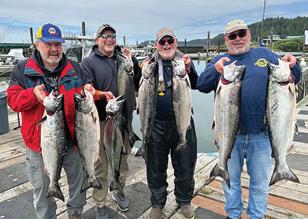






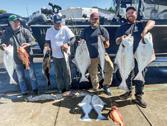

















HOW TO GET YOUR TROLLING GEAR TO DEEP WATER
By Cal Kellogg
Acouple weeks ago, I took four clients out to Folsom Lake aboard my pontoon boat. While they all wanted to catch fish, the primary focus of the trip was instruction. They all had boats of their own and were looking to take their trout and salmon trolling skills to the next level.
After we left the ramp around 6:30 in the morning, I noted the water temperature was hovering around 78 degrees. This told me the trout would be more than 25 feet down and the salmon would likely be quite a bit deeper than the trout.
I motored over to the south side
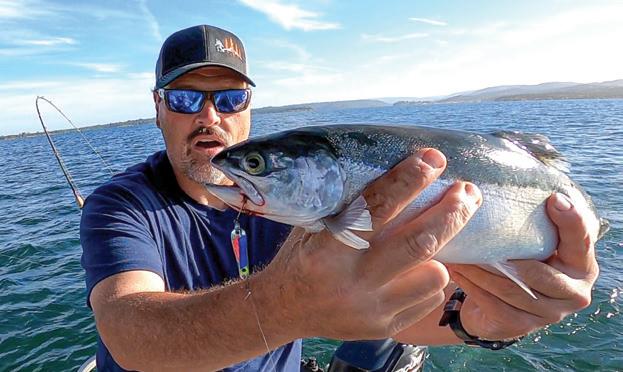
When summer temperatures soar, trout and salmon drop into deep, cool water, and a perfectly loaded rod working off a downrigger can be effective. Many anglers apply too much tension to the line and draw the tip of their downrigger rods down sharply. The problem with this approach is it makes it difficult to detect bites from fish that fail to trip the downrigger release

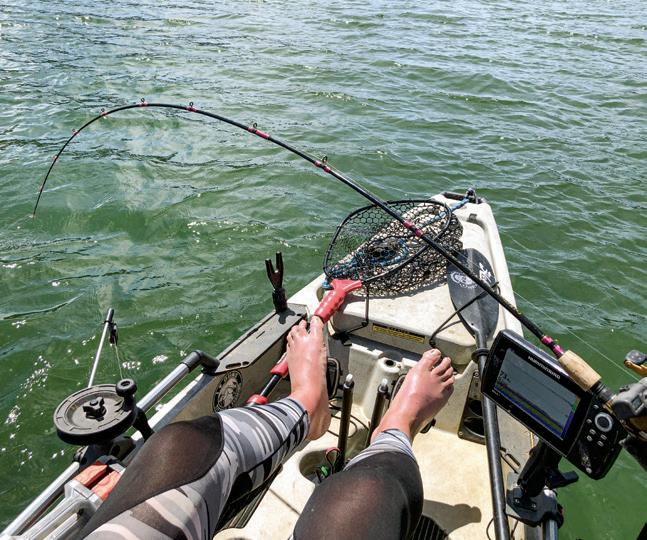
of the reservoir’s peninsula, slowed down and started scanning for fish on the sonar unit. Before long I found a handful of marks I thought were king salmon holding around an underwater hump 60 feet down. There was also a little scattered amount of bait showing around the hump.
Prior to spotting the kings, I’d marked the occasional fish scattered from 20 to 40 feet deep in open water. I was pretty sure these were rainbow trout.
I dropped a waypoint that marked the location of the suspected kings and got busy putting out gear. Within minutes I had hoochie and dodger combinations working off our two downriggers at 50 and 60 feet deep. These were my salmon baits.
Between the downrigger rods I spooled out a lead core rod, armed with a Pinhead Spoon, a rig intended to hook trout. I’d added a 1-ounce trolling sinker at the point where the leader was attached to the main line.
With the addition of the weight, I calculated I could get the spoon down
A downrigger can be highly effective when rigged aboard a pedal kayak. Notice that the angler has the rod loaded across the kayak, which allows him to keep a close eye on the rod tip looking for light bites or hookups that don’t trip the release. (CAL KELLOGG)
between 20 and 25 feet with only two colors of lead core. This would put the spoon just over the top of the most shallow trout.
Our fourth rod was set up with a 107mm Dipsy Diver trailing a Purple Haze Trigger Spoon Jr. on a 6-foot leader. The Dipsy was tuned to dive down and away from the starboard side of the boat.
I slowly spooled out 55 feet of line on the Dipsy rod. That put the spoon down about 35 feet, well outside the footprint of the boat.
On the first pass by the waypoint, the portside downrigger rod popped off and moments later we had a handsome 19-inch king in the box. Before I could get the salmon rod back down and come around for another pass on the salmon, the lead core stick wiggled to life and we landed a 15-inch rainbow. For the next 90 minutes the action was steady, with salmon smashing the downrigger baits and trout blitzing the spoons on the lead core and Dipsy rods.
When the bite around the
waypoint cooled off, we headed off in search of new fish. By that time, we had a combination of seven kings and rainbows in the box and were off to a great start on what would be a 20fish, full-limit day on Folsom.
Once the first flurry of action subsided, my clients started tossing out questions. Some were focused on the lures we were using, but most of the queries focused on getting lures down to depth using downriggers, lead core and divers.
I wasn’t surprised. Getting lures down to specific depths when the trout and salmon move deep creates a lot of question marks for beginningand journeyman-level trollers.
As you read these words in July, we have just moved into the hottest part of the fishing season. Trout and salmon will be holding in deep water between now and September.
Big, low-elevation reservoirs such as Shasta, Folsom, Camanche and Berryessa offer outstanding summer trolling, provided you understand how to get your offerings down to the fish anywhere from 30 to 100 feet below the surface. If you want to get in on this action, keep reading!
Here in the Golden State, downriggers have become synonymous with trout trolling. For the uninitiated, a downrigger is simply a large reel affixed to an arm that allows the angler to lower a large weight to a given depth. The line from your fishing rod is attached to the downrigger line via a clip (also known as a release). This way, you can lower your fishing gear to any depth you desire.
When a fish grabs your lure and is hooked, the line is pulled from the clip, and you fight the fish unencumbered by any sort of weight. Pretty simple stuff – so long as you don’t begin overthinking, which is exactly what most beginners do!
A question will come up: Electric or manual crank downriggers;







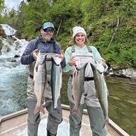


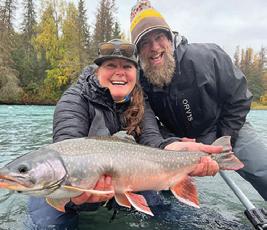



which is better? Frankly, I don’t care. I have electric Cannons on my big guide boat and crank 20-pound Scotty downriggers on my skiff and kayak. Electric downriggers are convenient, but crank downriggers are not excessively taxing to use. If you’re having trouble cranking up a manual downrigger, I’d advise you to hit the gym rather than run out and buy electrics.
As an aside, folks often ask if they should go with Cannon or Scotty downriggers? It’s a Ford/Chevy proposition. Both brands put out great products. I fish with both and have always found both brands to be rugged and reliable.
When you buy a downrigger, it will come rigged with stainless-steel cable. I always end up removing the cable and replacing it with braided line designed for downrigger use. The cable hums when it is drawn through the water. The sound doesn’t scare the fish, but it gets on my nerves!
What size and shape weight should
you use? Eight pounds is standard for lake fishing from a powerboat, while 4 is standard when fishing from a kayak. On my skiff I run with an 8-pounder, but on the big boat I use 10-pound weights. I do a lot of medium-fast to fast trolling, and the 10s exhibit less blowback than lighter weights.
I’m not a guy who goes out and buys the $100 chrome fish weights; they are cool, but in my view unnecessary. Over the years, I’ve used balls, stick weights and lead fish-shaped weights. In terms of fishing effectiveness, I don’t think it matters what you use. Balls oscillate a bit in the water. Stick weights also oscillate, but they are snag-resistant when you hit the bottom, and you will hit the bottom. Fish weights track really well and don’t oscillate or “walk” back and forth on turns.
When you buy new downriggers, they usually come with large line clips intended for use when trolling for ocean salmon. These are too large for the California freshwater fishing scene. You’ll want to pick up some smaller releases.
There are some high-priced
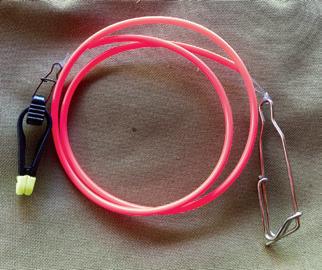
releases on the market that work really well, but I’ve never felt the need to upgrade from the simple clothespinstyle releases offered by Scotty and other companies.
When you attach your release to the downrigger, don’t attach it to the weight. Instead, utilize the stacking clip attached to the release to put the release on the downrigger cable above the weight. This way you can leave the downrigger weight in the water when you attach your fishing line to the release.
If you raise the weight out of the water in choppy water, or if there are boat wakes, the weight will swing wildly. You don’t want an 8-pound






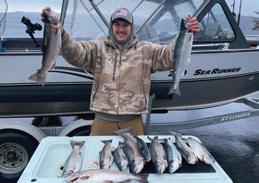






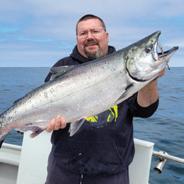





weight hitting your hand or the side of the boat.
The final consideration with downriggers is setback. Anglers are often confused about how much setback they should be running.
How far do you want your lure from the weight? The rule of 100 simplifies this question. Here’s how it works: Let’s say you are going down 60 feet, put 40 feet of line out behind the downrigger; 60 and 40 equals 100. If you are going down 30 feet, put 70 feet of line behind the downrigger; 70 and 30…
I started using divers about 10 years ago and found them to be highly effective. Divers work like this: Your main line attaches to a trigger mechanism and your leader attaches to the rear of the diver. When the trigger is engaged, water pressure generated by the forward movement of the boat causes the diver to plane down. When a fish strikes, the trigger disengages, the diver stops planing


and you fight the fish.
Divers do require heavier tackle than you’d use for downrigger fishing. Typically, you want your rod topped with a line counter reel spooled with 20- to 30-pound test braid. Braid has little stretch and is thin, allowing it to cut through the water very efficiently.
When you buy a diver there is a chart inside, which tells you how deep you can expect the diver to dive based on the amount of line you have out. Take a photo of that chart and store it on your phone for quick reference out on the water.
The only models of divers I use are the ones that allow me to tune them to go out away from the boat. It’s like a diver and mini side planer all in one. I don’t want the diver going down and getting tangled with my downriggers. Instead, I plane them out off both the port and starboard sides of the boat, allowing me to cover a wide swath of water while avoiding tangles.
When you get a new diver, you’ll need to adjust the trigger to trip with a light tug. Something I do is engage and disengage the trigger on a new diver a few hundred times by hand. This polishes the plastic inside the trigger and makes for crisp, reliable releases on the water.
When it’s time to reel in your diver to change lures, a sharp little hookset will trip the trigger. Every now and then you’ll hook a fish that doesn’t trip the trigger; in that situation you’ll give the rod tip the same sort of sharp jab and the trigger will release.
I typically run a 6-foot fluorocarbon leader off my divers. Most divers have only a barrel swivel where you connect the leader. I add a cross-lock snap to the swivel to allow me to quickly add or remove the leader.
When deploying the diver, I like to put my rod in the holder, as the diver will begin pulling almost immediately. If you spool the diver out with the







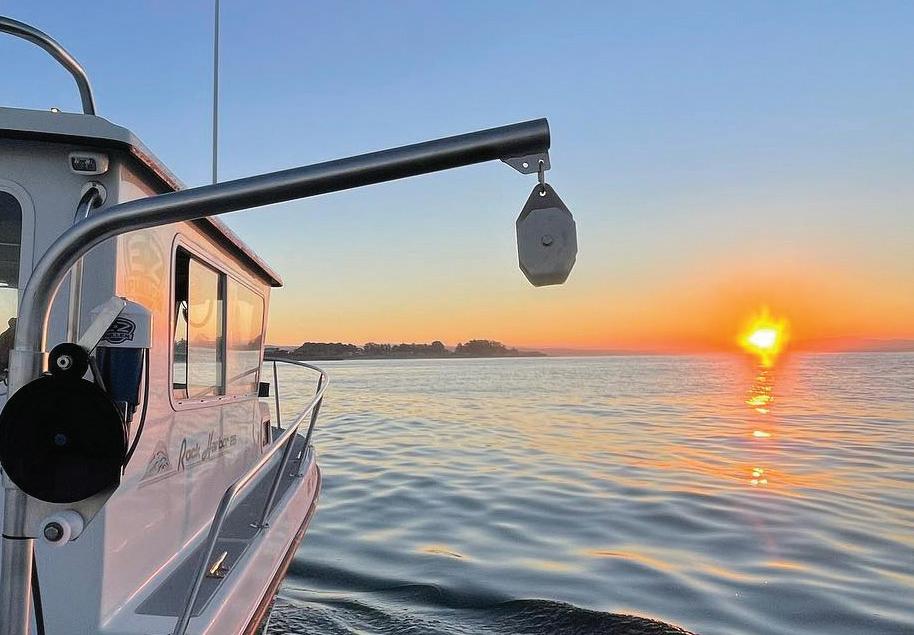

rod in your hand, you’ll often pop the trigger as you wrestle the rod into the holder, and then you’ll have to reel up and start again.
Finally, when you first put the diver in the water, make sure the leader doesn’t wrap the diver’s body; if it wraps, it won’t release once it’s
at depth. As you let the diver out, keep it under tension so it walks out gradually. If you drop it on a slackline, you may get tangled. Always keep the diver under control on the way down.
Lead core line has been around for a

very long time. It is basically a woven sheath with a soft lead wire inside of it. The color of the sheath changes every 30 feet. Basically, with a low drag lure at 2 miles per hour, lead core will get you down 5 feet per color.
In the old days, anglers would spool up with 300 feet or 10 colors of lead core, and with this they could get down 50 feet. This would require a large leader and 100 yards of line in the water.
I run hybrid rigs utilizing only three colors of lead core paired with 20-pound braid backing. I can get down about 25 feet with these rigs due to the thin, no-stretch properties of the lead core. In the cold-water months I seldom fish down beyond 20 feet.
I add a 50-foot, 20-pound test mono top shot to the lead core. In the summer I’ve been playing with adding 1 to 2 ounces of weight to the end of the top shot in the form of a trolling sinker.
With a 2-ounce sinker I can get down well over 30 feet with two colors of lead core in the water. When using additional weight, I cut the length of the top shot to 15 feet. If I’m running a 2-ounce sinker, I can be 30 feet deep with only 75 feet of line in the water.
Having done a great deal of controlled depth trout and salmon trolling over the course of my career, I urge you not to be intimidated by the prospects of having to fish deep. There is great action down there in the depths during the heat of summer.
While downriggers are the No. 1 tool for reaching down into the water column, don’t limit yourself. Play with lead core, weights and divers. There are days when lead core outfishes everything, and there are times when divers are hands-down the winning play.
The biggest rainbow I got guiding last summer, a sleek 27-inch beauty, came on a Dipsy trailing a Disco Minnow Jr. spoon 50 feet deep at 1.8 mph right at lunch time! CS


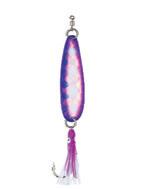
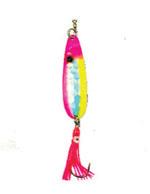









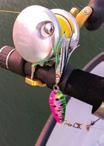

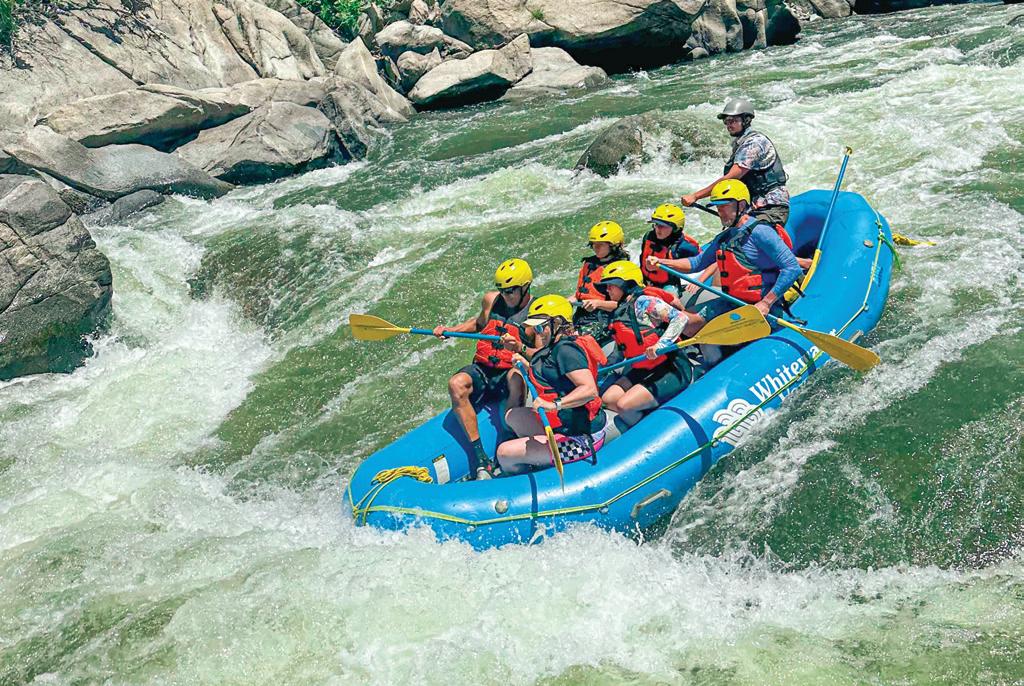




By Cal Kellogg
Living in the Sierra foothills, where good fishing exists here, there and everywhere, I’m not going to claim Rollins Lake is my favorite fishing destination. However, it’s a place I visit several times a year and seldom leave disappointed.
Located a few miles east of bustling Auburn, Rollins is a pass-by lake for thousands of anglers as they travel up and down Interstate 80. They pass by Rollins without giving the lake a second thought enroute to more prominent fisheries like Folsom, Donner and Stampede.
If you’re one of those anglers who






has sped by the Rollins Lake sign but never actually stopped to check the lake out, perhaps it’s something you should put on your to-do list. You’ll like what you find!
I’ll get into the fishing Rollins Lake offers momentarily, but since I’m a history nerd, let’s start with the fascinating history of the basin Rollins now occupies.
Rollins Lake is owned by the Nevada Irrigation District. The lake features 1.3 square miles of surface area at full capacity and came into existence in 1965 when Rollins Dam was completed to provide water storage and hydroelectric power generation. The dam impounds the waters of the Bear River and Greenhorn Creek.
Spaniards first explored the region in 1822. Seeing several grizzly bears
and ample bear sign, they dubbed the region’s main drainage Rio de Oso (Bear River).
The Bear River and surrounding hillsides happened to be rich in gold. During the gold rush – beginning in 1850 and extending into the 1900s –the region was combed by legions of prospectors; many abandoned tunnels can be seen along the lake’s shoreline.
There are local legends about scuba divers exploring the Numitor mine that lies beneath the lake. Miners extracted a massive amount of gold from the Bear River basin estimated to be worth $300 million in the 1800s, when gold was worth less than $20 per ounce.
A light gauge railroad and high trestle bridge were constructed by mining interests to bring supplies to the region and to transport gold back to banks in Auburn. The bridge stood
until the 1960s and was taken down as one of the first projects surrounding the construction of Rollins Dam.
In the midst of the prospecting boom, John Thorp and James Smith built a fish hatchery on what is now the Greenhorn Arm of the reservoir in 1866, where the state raised trout and salmon smolts.
Since Rollins Lake filled in the spring of 1966, a variety of different gamefish have been stocked in the lake, including brown trout imported from the Great Lakes, rainbow trout, kokanee, largemouth, smallmouth and spotted bass, channel catfish, crappie and bluegill.
The primary focuses of local anglers that ply the waters of Rollins Lake are trout and bass fishing, but folks who take the time to become
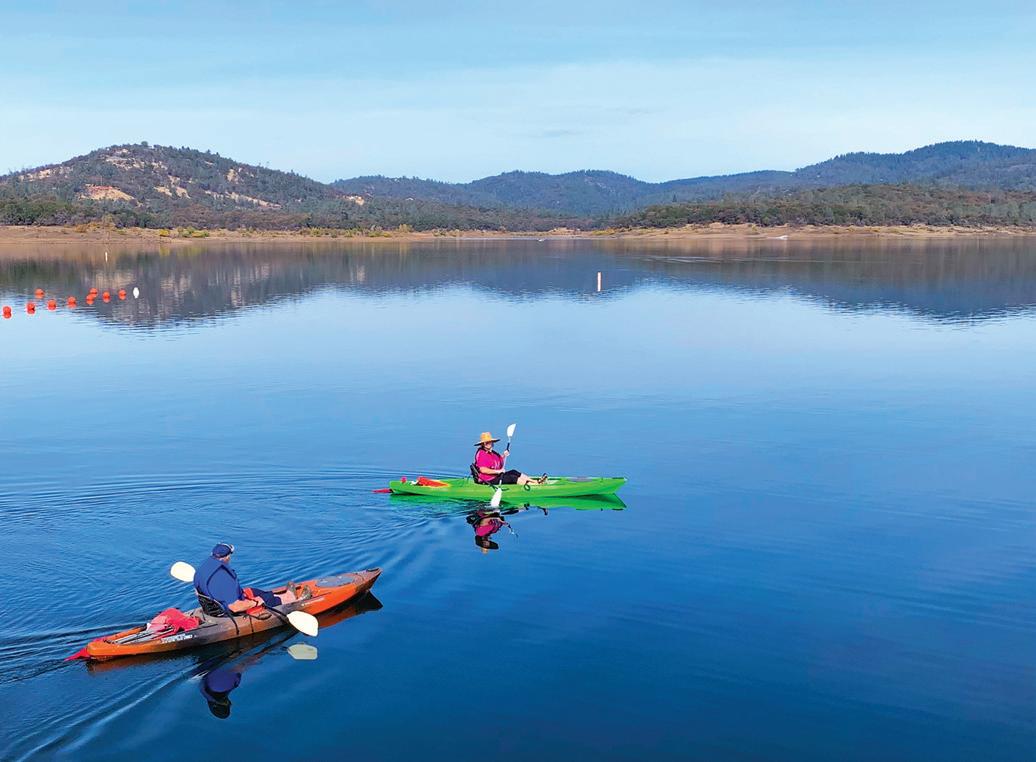


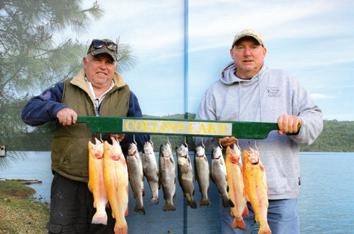


knowledgeable about the lake find good sleeper action for crappie ranging up to a pound and bluegill topping out in excess of 9 inches.
My fishing history with Rollins Lake stretches back nearly 30 years. While the fishing at the lake has remained consistently good over the past three decades, I have noted some significant changes. I’m a trout guy at heart so we’ll start there.
Rollins is typically planted with catchable rainbow trout three times per year between late January and April. And one thing I’ve observed over my fishing career is planted trout seem to acclimate much better to some lakes than they do to others. The trout planted in Rollins lock into the ecosystem very quickly. The planters tend to spread out fast and begin feeding on the lake’s prolific pond smelt population almost immediately.
It’s not uncommon to catch round tail planters that belch up freshly eaten pond smelt. This isn’t the case

at many of the lakes I fish where government rainbows are planted. Combine the planter’s ability to feed with Rollins Lake’s deep cold water and the stage is set for an exciting holdover rainbow population. While solid numbers of holdovers

can be found in Rollins and forage is plentiful, the trout don’t grow exceptionally large. Fish measuring 12 to 15 inches are common and the biggest rainbow I’ve ever seen caught at the lake was a 21-inch fish my wife landed.
Over the years, Rollins has been planted with brown trout on an inconsistent basis, but a wild brown population has been established. Overall they are harder to catch than rainbows. Occasionally you’ll hook one on “rainbow” gear, but if you specifically target browns, you’ll get them with consistency.
The average browns I’ve caught over the years run 16 to 20 inches, with my largest Rollins brown to date measuring 31 inches. Without much large forage to consume the browns tend to grow long and lean. I’d be surprised if my 31-incher weighed much over 5 pounds, but he was sleek, silver, covered with bold black spots and put up a determined battle with a crazy jump and several power dives.
The Bear River is the reservoir’s primary tributary. The river is cold and the stretch of canyon above the lake is wild and remote. There is a lot of


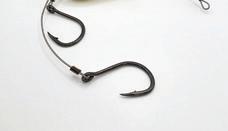









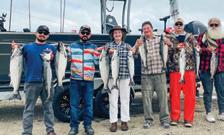




interplay between trout and the river. In the winter and spring, you’ll encounter rainbows and browns that appear to have moved out of the river to feed in the lake. Likewise, during the summer some of the lake’s holdovers follow the Bear’s cold, welloxygenated inflows up into the river.
Spawning definitely takes place in the Bear because I’ve hooked 3- to 4-inch browns and rainbows. These fish are smaller than the trout the California Department of Fish and Wildlife plants, plus they’ve been perfect fish with healthy tails and not
so much as a scale out of place.
Let’s say you want to hit Rollins Lake and hook a mess of trout. Everything is dictated by temperature. When the surface temperature is 65 or below, you’ll likely encounter fish in the top 15 to 20 feet of the water column. As the surface temperature rises, expect the trout and pond smelt to drop into deeper, cooler water.
If you’re fishing off the bank, November through April is your time. The No. 1 approach for hooking

rainbows, both planters and holdovers, is a ball of PowerBait soaked off the bottom using a Carolina Rig. Tossing hardware in the form of Kastmaster spoons and Panther Martin spinners can also pay dividends.
I’ve had my best success hooking browns from the bank using a slip bobber setup to drift whole night crawlers from 5 to 15 feet deep. Browns love meat, so they have a tough time passing up an easy-to-gobble worm.
Trollers targeting rainbows do very well pulling a variety of spoons, including Needlefish, Trigger Spoons, Trigger Spoon Juniors, Hum Dingers and Speedy Shiners. Spoons are a good match for the 1- to 3-inch pond smelt the rainbows eat. All you need to do to hook up is match the speed and color of your presentation to the day-to-day preferences of the rainbows.
I like to start with natural-colored spoons pulled around 2.5 mph. If the natural patterns don’t work, start playing with bright oranges, pinks and chartreuse.
For browns spoons will work, but I’ve had much better luck power trolling with Rapala minnows in the 3- to 5-inch range. Rainbow trout patterns are good, as are blue over silver and black over silver models. The 31-inch brown I caught smashed a 4-inch silver and black Husky Jerk trolled at 3.5 mph right along the bank in Long Ravine Cove.
I’ve caught rainbows all over the lake, but many of my browns have come from the Bear River Arm during the dead of winter. One of my all-time favorite areas for rainbows is the spot where the power lines cut across the mouth of the Bear Arm.
The Bear River Arm is also the spot where I caught my one and only kokanee from the lake. It was a handsome 14-inch landlocked sockeye that grabbed a threaded night crawler pulled behind a set of flashers. Friends of mine have accidentally caught the occasional kokanee out


Rollins’ rainbows are ready strikers and it’s usually not difficult to round up a limit while pulling spoons. “If you’re one of those anglers who has sped by the Rollins Lake sign but never actually stopped to check the lake out,” the author writes, “perhaps it’s something you should put on your to-do list.” (CAL KELLOGG)

of the lake, but I’ve never heard of anyone getting them consistently. Kokanee plants decades ago must have successfully established a modest spawning population of salmon.
Let’s move on to bass fishing. For a long time, Rollins was known for producing big numbers of sub12-inch smallmouth bass and the occasional 2- to 5-pound largemouth. About a decade ago, I started catching the occasional spotted bass in the lake. How did they get there? I suspect some bass angler brought them to Rollins from another location.
Regardless of how the spots made it to Rollins, they prospered. These days spots from 1 to 3 pounds are common; my personal-best spot weighed in at 4 pounds.
Based on my observation, spotted bass have caused a decrease in the smallmouth population, but the smallies I do catch have gotten larger on average. Rather than hooking 9to 12-inch smallmouth, I’m catching fish from 1 to 2 pounds.
While I’m not a hardcore bass guy,
bass fishing at Rollins is fun. There are lots of downed trees in the water, so you often find fish holding on to wood. This is unique in California, where the fluctuating level of our reservoirs leaves us primarily fishing submerged rock structure.
During the prespawn and spawn period, you can catch plenty of bass on plastics in the form of Senkos and finesse worms worked around shallow flats. I’ve seen that the best bass action actually takes place after the spawn, when the fish put on the feed bag and begin blitzing smelt.
Early and late, these fish are suckers for small poppers fished around trees and along steeply dropping shorelines. During the day bass will move out into 10 to 15 feet of water and can be taken on crankbaits, spinner baits and pretty much anything that resembles a small baitfish.
This will probably make heads hurt for any bassers, but during the month of June I’ve smacked bass while pulling trout spoons across flats on my hybrid leadcore rigs. Bass
are on the hunt for baitfish, and a chrome tone Trigger Spoon zipping along at 2.5 mph behind my kayak is just what the doctor ordered!
June was also a great month for targeting panfish. For bluegill, red worms and crickets fished beneath bobbers around the lake’s fallen trees work great. Don’t expect to find quality bluegill in every location. You’ve got to hunt for them. For whatever reason, you’ll find hot action on one tree and the cover along the rest of the bank will be devoid of fish.
I would have never targeted bluegill at Rollins had I not caught a ¾-pounder one day on a popper I was trying to tempt spotted bass with. Based on that experience, I’m sure a fly rodder armed with some panfish poppers and flies could have a great time at Rollins.
Disclaimer: I’ve never caught a crappie at Rollins. However, when I owned the Fish Sniffer magazine, a retired gentleman repeatedly sent me photos of big, beautiful crappie he pulled from the lake on jigs and small minnows. I pressed him for details, but he kept things vague. He told me he got them in the Greenhorn Arm fishing deeper than most anglers expect to hook crappie. One of his photos from a July outing verified his story.
He had about a dozen nice slabs laid out and two quality brown trout. During that time of the year, I’d expect the browns to be 25 to perhaps 50 feet deep depending on the time of the day, backing up the gentleman’s assertion that he found his crappie in deep water.
With some patience and a good sonar unit, finding the crappie shouldn’t be too much of a chore if you are really interested in hooking some Sierra slabs at this underrated fishery. Don’t ignore it on your 80 trip to the high country! CS
Editor’s note: Cal Kellogg is a longtime Northern California outdoors writer. Subscribe to his YouTube channel Fish Hunt Shoot Productions at youtube.com/ user/KelloggOutdoors.
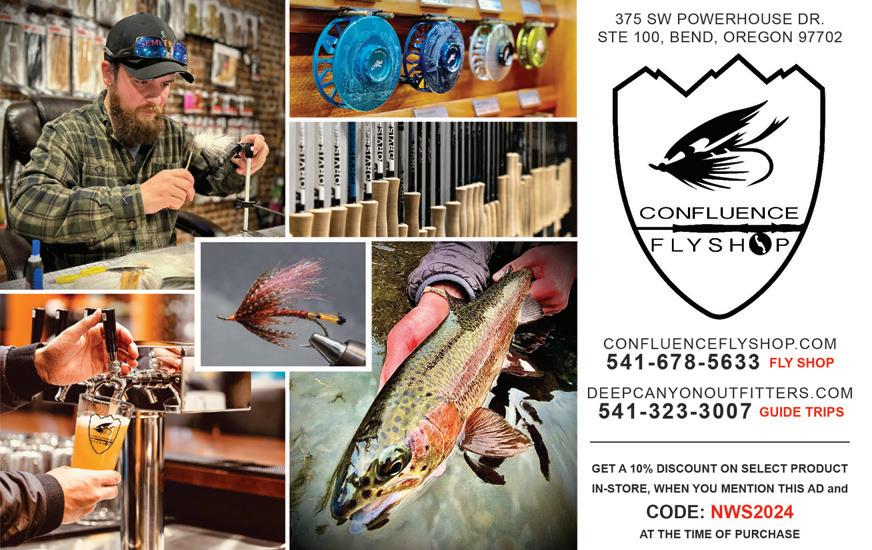


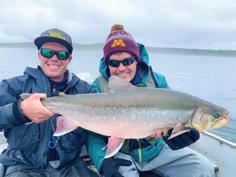






By Mark Fong
Perhaps one of the most overlooked sport fish in California is the American shad. While shad certainly have a group of hardcore followers, for many anglers they are somewhat of an enigma. To start off, a little background is probably in order.
The American shad is not a native species to the West Coast; in fact, they were first introduced to the
Sacramento River from the Atlantic coast during the 1870s. Shad today inhabit a range that extends from California all the way north to Washington State.
The shad is a member of the herring family. The fish are anadromous, spending the majority of their adult lives in the ocean. At maturity they return to freshwater during the spring to spawn.
The largest runs of shad in the Northern California area occur in the
Sacramento, Feather and American Rivers. The runs typically begin in April, peak in late May through June, then taper off in July. Shad are broadcast spawners and most spawning occurs during nocturnal periods. Smaller males run between 1.5 to 3 pounds, while the larger hens can weigh between 3 to 5 pounds.
Shad are excellent fighters on light tackle. They are known for their

ability to make long and powerful runs and will often go airborne in spectacular fashion as they attempt to throw the hook, thus earning the moniker “a poor man’s tarpon.”
I don’t get to fish for shad nearly as often as I would like, in part because the season is relatively short and also because there are so many additional great angling opportunities during this time of year. Thus, when my buddy Dan Valdez, the proprietor of Draggin’ Flies by Dan, called me up and told me the shad were running, I couldn’t resist the offer to join him and my friend Ian Rigler for an afternoon trip on the Sacramento River near Chico.
We launched Dan’s jet boat at Pine Creek Landing on a very warm day in May. Dan carefully navigated the small slough leading to the main river. Once on the Sacramento, Dan headed downriver several miles before setting anchor above a deep, slow-water pool.
Dan gave me a small hand-tied pink shad fly and two small split shot weights. I tied the fly to my 4-pound fluorocarbon line and carefully crimped the small weights a foot or so above the fly. I made a short cast slightly down and crosscurrent.
I let the fly swing until it was behind the boat and then I placed my rod in
the rod holder. The objective is to keep the fly just above the bottom where the shad are holding. Shad anglers call this technique the “dangle.” Now it was simply a matter of waiting for the schools of fish to filter through. Shad travel in schools, but unlike other fish that group up in bunches or wads, shad move in long almost single-file lines. This can make locating them difficult, so it is important when using the dangle to make multiple casts and to vary their length and position until you zero in on the lane that the shad are using. Once you find them, it is important to make note of where you cast your lure and to duplicate that presentation



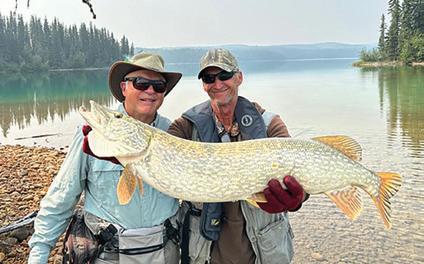




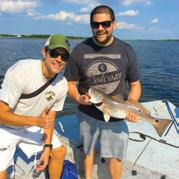
and location.
It was a beautiful time to be on the river, but the shad were not in a super cooperative mood. Over the next few hours we each had the pleasure of catching several nice fish, but the action was nowhere near what Dan had experienced on his last visit to the river. Dan noted that the water had a bit more color and the flows were higher.
After a period of extended nothingness, Dan began bouncing around to other holes. The story was much the same everywhere we stopped: a few small windows of action mixed in with longer stretches of inactivity.
With the sun sinking low on the western horizon, Dan decided to make the last move of the day. Shad are notorious for going on the bite during the last hour of daylight and this evening was no exception.
Dan was first to hook up with two nice shad in succession. And then it was my turn. I had just placed my rod in the holder when I got thumped hard.


I picked up my rod and the shad made a long, powerful run followed by an acrobatic jump. This is exactly why I love to fish for shad; they are excellent fighters, especially on the ultralight tackle. Following several more powerful runs, I had the fish at the side of the boat, where Ian was waiting with the net. We took a moment to snap a picture and quickly released the shad back to the river.
Time certainly flies when you are having fun. We were able to catch a few more fish before the impending darkness forced us back to the launch. If you enjoy fishing light tackle, the American shad is definitely a worthy challenger. CS
Editor’s note: Like Draggin’ Flies by Dan at facebook.com/profile.php? id=100057077874828.



























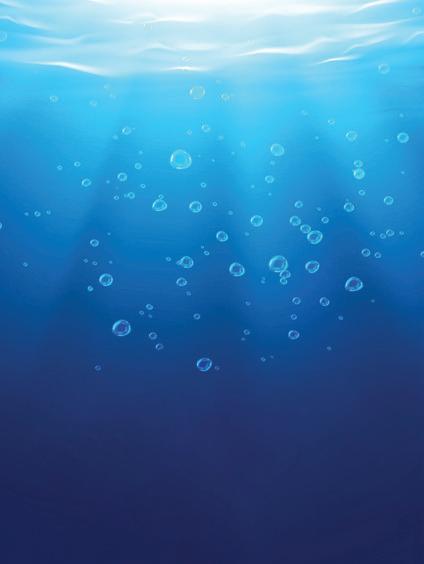

By Meghan Snow
“This year looks a lot different than last year,” said Jerrod Sellers, a wildlife biologist with the U.S. Fish and Wildlife Service’s Sacramento Fish and Wildlife Office. “We haven’t seen nearly as many adult hitch running up to spawn in the tributaries.”
Last year, thousands of adult Clear Lake hitch were seen swimming up the creeks and streams from Clear Lake to spawn. The number was so large that locals and biologists were regularly rescuing stranded adult and juvenile hitch from agricultural and stormwater drainage ditches along the creeks. The
numbers left biologists bewildered and ecstatic. They hadn’t seen numbers like that in the past five years.
This year is, indeed, different. Biologists monitoring the creeks daily have reported seeing fewer adults swimming upstream and only a few dozen spawning. They have also reported seeing juveniles at the mouths of the creeks.
What happened to all the fish that were seen in 2023?
“Weather is a key factor in triggering spawning activity,” said Sellers.
The hitch run upstream to spawn starting in mid-March through late April. They wait in the lake until the water in
the streams reaches about 60 degrees Fahrenheit. But this year, two cold weather fronts swept into the region right when the fish were lining up at the edge of the lake to make their journey upstream. The temperatures dropped, the water got cold, and the fish retreated into the lake, waiting for warmer conditions. Just as conditions warmed again, another cold front blasted the region. By then, it was too late for the fish to make their spawning journey.
However, the presence of juvenile hitch in the streams is a good sign.
“Seeing young fish in the tributaries means they survived their first or second year in the lake and are still following their natural instincts to swim upstream
even though they’re not quite mature enough to spawn,” said Sellers.
Clear Lake hitch usually mature at 2 to 3 years of age and can live for up to six years. The first few years of life are the hardest for the fish. Hitch eggs are a favorite food of large catfish that suction the bottom of the lake and streams where the eggs rest.
As small hitch, they become a delicacy to striped bass and bullfrogs. For a few years, very few juvenile fish were seen in the lake, leaving biologists to wonder if a younger generation of fish was present or if they had all been gobbled up. Recent sightings help put that questioning to rest.
The U.S. Fish and Wildlife Service is working closely with biologists and representatives from the local Tribes, U.S. Geological Survey and California Department of Fish and Wildlife to build an understanding of this species and its status in the lake today. That body of knowledge is founded on the Tribes’ historical accounts of the area and the prevalence of the fish. The Tribes and biologists work together to build additional data, including population surveys, habitat reports and studies that provide information on fish age and where it traveled.
“Along with understanding the population numbers and the lifecycle of the fish, we need to restore the habitat in the area,” said Sellers.
Clear Lake has lost more than 85 percent of the wetlands that once lined the shores, and tributaries have become clogged with Himalayan blackberry vines and dirt from eroding streambanks. This shift in habitat poses a threat to the hitch that evolved to rely on wetlands for raising juveniles and floodplains for spawning.
In late April, the Service announced a $2.5 million grant that will restore habitat and improve fish passage between Blue Lakes and Scotts Creek. The Tejeda
Ranch Habitat Management Project will clear debris dams and plugged culverts in the area. About 60 percent of the adult hitch travel to the Scotts Creek watershed for spawning, making this area a key priority for habitat restoration.
In addition to supporting the Clear
Lake hitch, the project will also benefit Clear Lake tule perch, foothill yellow-legged frog, California red-legged frog and Sacramento sucker. Many partners came together to support this project, including the Robinson Rancheria of the Pomo Indians of California, the Yurok
“Weather is a key factor in triggering spawning activity,” said U.S. Fish and Wildlife Service biologist Jerrod Sellers in concluding why fewer fish seem to be spawning, though he cites a healthy amount of juvenile hitch as a promising sign.“Seeing young fish in the tributaries means they survived their first or second year in the lake and are still following their natural instincts to swim upstream even though they’re not quite mature enough to spawn.” (MEGHAN SNOW/USFWS)



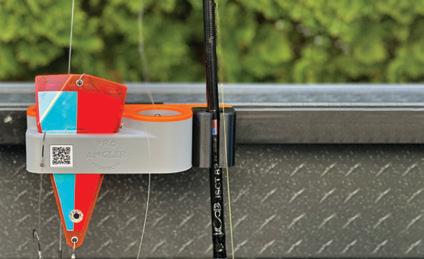





Tribe's Design and Construction, California Department of Water Resources, Tribal Eco-Restoration Alliance, California Department of Fish and Wildlife, Caltrans, and Lake County Watershed Protection District.
“We’ll start planning efforts for this project in the fall with the goal of breaking ground in 2025. This project will un-
doubtedly be positive for the Clear Lake hitch,” Sellers said. “We’re grateful for all our partners coming together on this effort.” CS
Editor’s note: Meghan Snow is a public affairs officer for the U.S. Fish and Wildlife’s Sacramento office. For more on the Service, go to fws.gov.





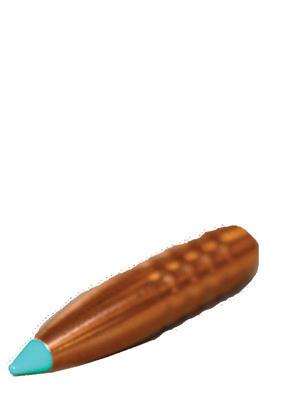




Author Scott Haugen arrowed this whopper coastal Columbian blacktail in the closing moments of opening day after moving his blind 200 yards closer to the buck’s core bedding area than where he’d hunted that morning. Trail cameras revealed the buck stripped its velvet two days before the opener. Preseason scouting can pay off.
By Scott Haugen
Whether you hold an early-season archery tag and are hoping to score on a velvet-racked blacktail, or you’ll be hunting this fall’s general rifle season, now is the time to get out and scout. When bucks are in velvet, they’re
visible. Bucks don’t want to damage their valued headgear, which is not only used as protection against predators, but also for fighting with other bucks during the rut. Racks are also a status symbol.
In July, I like glassing the first few hours in the morning when blacktail bucks are most active. I also like look-
ing for velvet-racked bucks in late afternoon as soon as draws and hillsides become shaded. It doesn’t take a big drop in temperature for bucks to start moving in the hot summer months.
Scouting during the hottest part of the day can also be productive. This is be-
By Tiffany Haugen
Smokers aren't just for fish! Whether it’s a special holiday meal or a fancy weeknight dinner, stuffing a wild game backstrap or tenderloin makes a beautiful, crowd-pleasing presentation, and it keeps the lean cut of meat very moist. Because everyone has their own favorite stuffing recipe, the substitutions and variations of this part of the recipe are endless. Just make sure there’s a generous amount of added fat – i.e. bacon or sausage – with pan drippings that can be used instead of butter.
The recipe here is using a portion of elk backstrap. I’ve also made this recipe with deer, antelope and black bear, and they all turned out delicious. Adjust the stuffing volume to accommodate larger or smaller cuts of wild game as necessary, and enjoy.


1- to 2-pound wild game backstrap
½ cup butter
One diced onion
1 cup diced celery
¼ cup diced red bell pepper
1 tablespoon minced garlic
2 tablespoons capers
¼ cup dried cherries or cranberries
¼ cup minced carrot
¼ cup finely chopped kale or spinach
½ cup beef stock/broth
2 cups dried bread cubes
One egg, beaten
1 teaspoon poultry seasoning
½ teaspoon salt
½ teaspoon pepper
1 tablespoon flour
One oven roasting bag
Smokehouse wood chips (desired flavor)
Trim all silver skin from backstrap. Using a large knife, butterfly backstrap to a 1-inch thickness. Place wax paper over backstrap and pound meat to about a ½-inch thickness using the smooth side of a meat mallet. Even thickness by using the waffle side of the meat mallet if necessary. Sprinkle backstrap with salt and pepper.
Preheat your smoker for 10 minutes. Add desired flavor of wood chips to the chip pan. Place butterflied backstrap on smoker rack. Smoke for 30 to 40 minutes or through one pan of chips. This will be enough to in-
fuse smoke flavoring into the meat.
In a large skillet, melt butter on medium-high heat. Caramelize onions five to 10 minutes. Add celery, bell pepper, garlic, poultry seasoning, salt and pepper, and continue to sauté for an additional five minutes. Add cherries or cranberries, carrot, kale or spinach, sautéing an additional five minutes. Remove from heat and let cool slightly. Stir in broth, bread crumbs and beaten egg, gently mixing to combine.

Place an oven-safe cooking bag in a casserole pan and sprinkle the bottom portion with 1 tablespoon flour. Spread stuffing evenly over butterflied backstrap. Roll backstrap up and truss with kitchen twine. Place the trussed backstrap in oven bag. Secure the bag using enclosed oven-safe twist ties. Cut six ½-inch slits in the top of the bag so steam can escape.
Bake in a preheated 350-degree oven 45 minutes or until backstrap temperature reaches 155 degrees on an internal thermometer. (Bag may be opened during the last 10 minutes of cooking time to brown the top.) Let backstrap rest 10 minutes before slicing into serving portions.
Editor’s note: For signed copies of Tiffany’s popular book, Cooking Big Game, and other best-selling titles, visit scotthaugen.com.

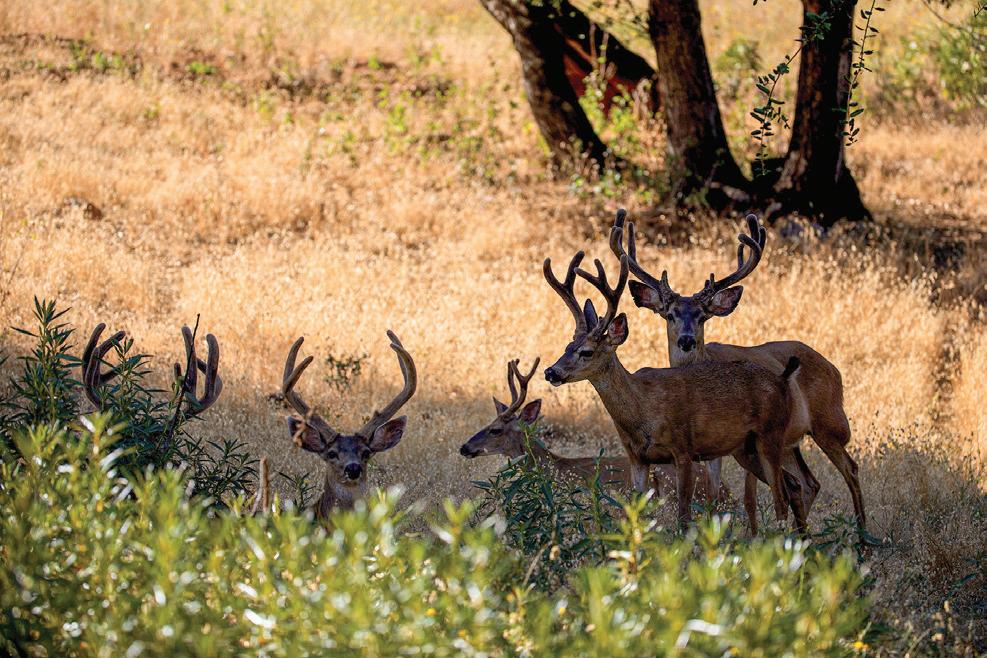
cause as the sun hits a bedded buck, it will get up to re-bed in the shade. Bucks bedding in open habitat will often change beds multiple times a day.
Whether you’re in hunting areas that are familiar to you or heading to a new place this season, there are certain keys to consider when scouting in the summer. Once you’ve located a buck, study the land. It’s critical that you intimately know the lay of the land, so when hunting season comes you can anticipate where a buck might be and know how to get to it.
Now is also a good time to locate camping spots. So many times I’ve found more bucks in a single day of summer scouting than I’ll see during the entire time I’m hunting them. On July 10 one summer I saw 17 blacktail bucks in the
foothills of the Cascades. I hunted that area for 28 days and saw one legal buck the entire season. Hunting pressure was what I blamed for keeping bucks in deep cover; they moved only under the cover of darkness. Had I not seen them in the summer, I wouldn’t have thought there was a deer within miles.
A couple winters ago one of my hunting areas was obliterated by an ice storm. So many trees and big branches fell that it impeded deer travel routes. In fact, it shut down deer travel to the point they had to relocate to another drainage.
Sometimes natural disasters like snow and ice storms, even high winds or fires, can influence where deer live and how they move. It’s no secret that many old blacktail bucks
live in a very small area, and the deer will move, sometimes several miles, if that habitat is devastated by sudden environmental changes.
Wildfires have greatly changed the face of the blacktail woods in recent years. Today, large-scale wildfires are commonplace, and I’m learning a lot about deer movement based on burns, the intensity of burns, and where deer are moving in response to them. But most importantly, I’m understanding why deer are choosing to live where they do in their respective habitats, and it’s helping me find more bucks in relation to fires around them.
Keep track of wildfires this summer and monitor their size and severity. Big fires are easily tracked on the internet, as well as by making calls to

regional forestry and wildlife offices.
If planning on hunting an area that’s near a wildfire – or in a region where wildfires have occurred – have a backup plan. Every fall in recent years, areas are closed right before, even during a hunting season. Having another place to hunt blacktails is wise.
Due to so much land being shut down by wildfires, more hunters are being forced to hunt in closer proximity to one another. Hunting pressure has an immense impact on blacktail
buck movement. Most bucks will go nocturnal with the onset of human intrusion – often in a matter of hours – and killing mature bucks becomes near impossible.
The number of bucks I’ve found when scouting in the summer, then actually killed, is surprisingly low. That’s because I’m mostly hunting blacktails in thick cover. Though I may not find a target buck, I’ve filled a lot of tags

in the same areas where I’d seen big bucks when scouting in the summer. This is because I’m hunting where big bucks want to be.
If you kill a big buck you’ve never before seen, figure out what brought it there. It could be feed, cover, predators, hunting pressure, even a severe storm. At the very least, plan on hunting that same spot at the same time the next season, for if all factors remain constant, another big buck will be there; maybe you’ll even find it when scouting in the summer.
If you want to take your deer hunting success to the next level, summer scouting will help locate bucks, so come opening day you can be in the right spot, as Haugen was for this California blacktail. (SCOTT HAUGEN)
One August I held a general season archery tag in Northern California. A buck a buddy and I caught on a trail camera traveled virtually the same trail at the same time in the morning for three weeks prior to the hunt.
But in the morning I hunted from a ground blind, and it didn’t show up. By 11 a.m. it was over 100 degrees outside the blind. I was soaked in sweat. The next day was supposed to be even hotter, so we moved the blind a couple hundred yards up the oak-studded hillside.
The move paid off, and around 9 a.m. the big buck walked by and I filled my tag. Our thinking was simple. Hotter days meant deer would be seeking cooler conditions sooner, and here where water was lacking, that meant heading to the crests of hills, where they could bed in the shade and catch uplifting thermals to cool them down.
Summer scouting requires time and effort, but it’s one of the best ways I know to take your blacktail hunting knowledge to the next level. Big blacktails are smart and most visible in summer, which means now is the time to find them. CS
Editor’s note: For signed copies of Scott Haugen’s best-selling book, Trophy Blacktails: The Science of the Hunt, visit scotthaugen.com. Follow Scott on Instagram and Facebook.







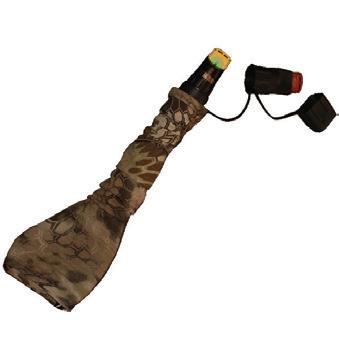


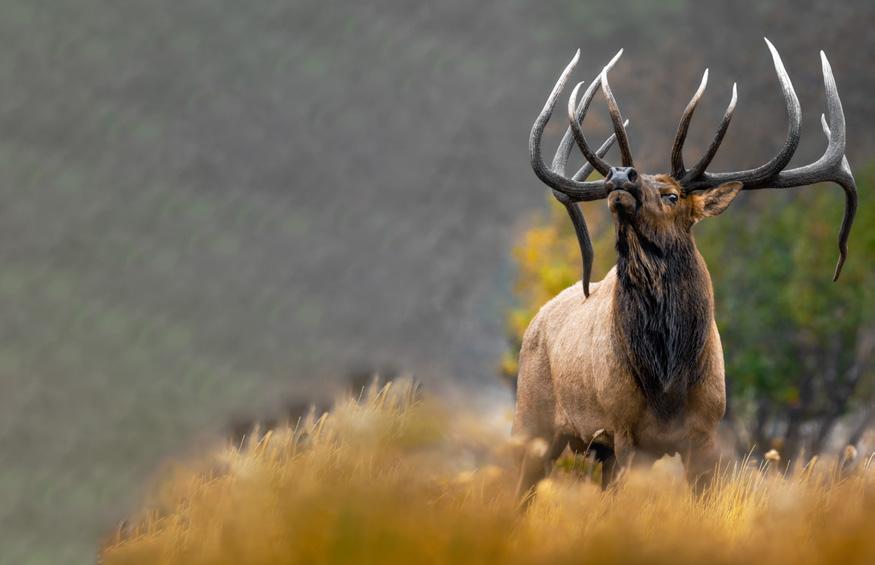




General rabbit season opens on July 1 in California, and author Tim Hovey has plenty of memories of hunting cottontails, so
looking
to
By Tim E. Hovey
Ileaned against an oak tree, facing a crease of sage 50 yards away and slightly uphill. Resting on my knees was a scope-mounted, leveraction .22 I had borrowed from my dad’s cousin.
Minutes earlier I had surprised a jackrabbit while hiking near a
drainage and he had escaped to the sagebrush I was facing. At 13 I can remember thinking that I was willing to sit there all day waiting for him.
About a half hour later, a rabbit fed its way out towards a small opening in the brush. My heart was pounding as I steadied the crosshairs on his shoulder. At the shot, I lost sight of the rabbit and hurried up the hill. I
spotted blood where he had been standing and then found the dead cottontail a few feet away. My first game animal, and my first cottontail rabbit, fell that day.
MANY HUNTERS START DOWN the path of hunting small game such as rabbits. We learn subtle hunting techniques like stalking, patience

planned,”
disrupts
annual

and persistence. These attributes are honed over decades of pursuit and help us become better hunters. Along the way, we add in observation, habitat recognition and specific game animal behavior. For me, it all started on that hillside at the age of 13.
It doesn’t matter what I have planned; nothing disrupts my annual plans for the July 1 cottontail rabbit opener. A month before the season opens, I make plans to scout a handful of tried-and-true spots. Time permitting, I’ll head out the evening before and camp out so I’m on the hunting grounds at first light.
The California cottontail season stretches almost seven months, running from July 1 through January 26. The daily bag limit is five rabbits per hunter, with 10 in possession.
Cottontail rabbits are more active in the mornings and the evenings. Like most small animals, they are
usually never far from a consistent water source. In the desert, I’ll look for green vegetation, usually indicating a spring or watered creek close by. If I can find this type of habitat, rabbits will be close.
Thick vegetation, like sage or rabbit bush, routinely spring up in these damp areas, providing cover for rabbits and protecting them from predators. They can also find some relief from the midday heat in the shade of the thick brush. Underground burrows are often hidden in these brushy areas, providing added protection from the heat and predation.
If these habitat types hold rabbits, they’ll usually be covered in rabbit scat and prints. Cottontail rabbits will hold tight in heavy cover when danger is close, bolting for safety as a last resort. A quick walk through these brushy areas will tell you all


Hovey says the most common way to find a five-rabbit limit is to kick the brush in good habitat with a shotgun.
“Keeping the sun at my back, I’ll move through the area and make sure that I contact the brush with my leg as I walk through,” he writes. (TIM E. HOVEY)
you need to know when it comes to rabbit presence.
PROBABLY THE MOST COMMON way to pursue rabbits is kicking the brush in good habitat with a shotgun. Keeping the sun at my back, I’ll move through the area and make sure that I contact the brush with my leg as I walk through.
Cottontail rabbits will often sit tight, racing for cover at the last second. This is the hunter’s opportunity. I call this type of hunting snap shooting. Escaping rabbits won’t give a hunter much time to squeeze the trigger. Often, you only get a quick flash of fur punctuated with that bright white cotton ball of a tail before they escape. This type of hunting will definitely sharpen a hunter’s instinct shooting skills.
Another way I like to hunt cottontails is to set up on a high spot and glass for feeding rabbits just at sunrise. Using a set of shooting sticks and the insanely accurate .17 HMR



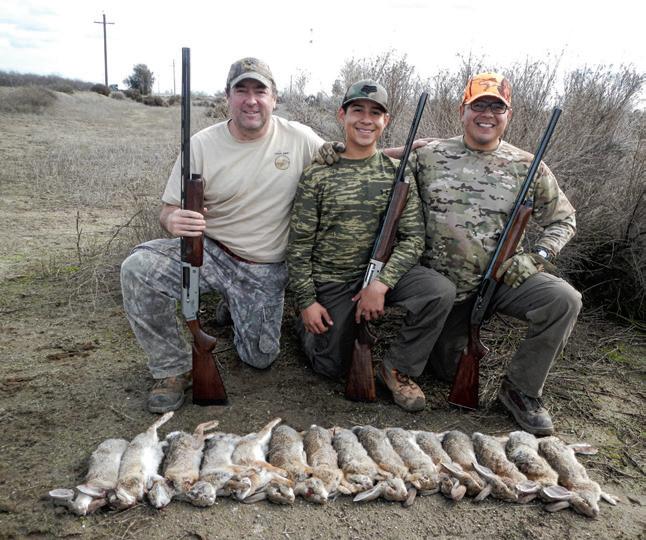
rifle, I can easily snipe bunnies out to about 150 yards. Again, I try to keep the sun at my back to hide me a bit and to give me a better view of the terrain.
Rabbit meat is one of my favorite types of game meat. It’s a white meat that picks up the flavor of just about any marinade. My favorite way to prepare the meat is to butcher the rabbit into quarters and to pan fry the portions in olive oil until brown. I then transfer the meat into a casserole dish with two cans of cream of mushroom soup. Cooked at 400 degrees until done, it’s one of my family’s favorites.
THIS JULY, STEP BACK in time to where it all started for most hunters and chase cottontail rabbits. For me, it takes me back to where I started.
I remember all those things I’ve learned since, knowing it all started years ago, leaning against a tree, mounted up behind a borrowed .22 lever-action. CS












By Scott Haugen
Ilet Kona out the back door for one last potty before bed. The moment he entered the glow of the porch light, it was clear something wasn’t right. His gate was off, ears and head down. Then I saw the snarl, the one he makes when he gets a mouthful of skunk spray. It was 11 p.m.
“Skunk!” I hollered to Tiffany, who was on her way to bed. I grabbed Kona and wiped his mouth and face with a dry towel we always keep outside. By the time I was done, Tiffany was there. She had dishwashing gloves on and a bucket of hot water with the necessary ingredients. We call it the skunk bucket. This was Kona’s third skunk encounter, and this time we were ready.
KONA’S FIRST ROUND WITH a skunk found us ill-prepared. We were on a family hike. Both of our sons were with us. It was the middle of the day and we were an hour from home. A half-mile from the truck, we all saw it at the same time – a black and white tail bobbing through tall, yellow grass. Kona and Echo had been chasing bumpers the whole time, so they were not leashed. Before we could react, Kona saw the skunk and tore off after it. Echo is shorter and didn’t see it. One of the boys grabbed her. Kona caught the skunk, gave it a shake and got a face full of spray. Fortunately, he let go. A river was nearby and we had Dawn dishwashing
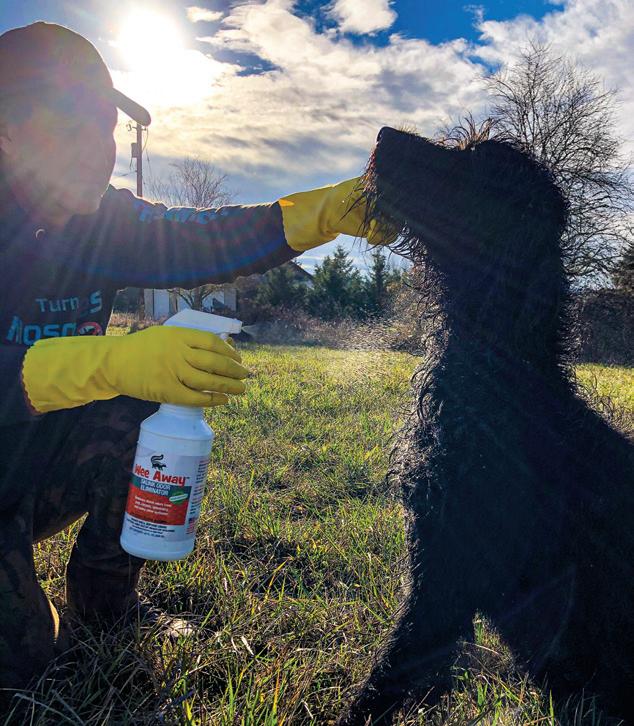
When you have a gun dog that can’t stand skunks – looking at you, Kona – you need to have a deodorizing plan ready. Not all commercial sprays or home concoctions work, author Scott Haugen has learned the hard way. (SCOTT HAUGEN)
soap in the truck. Kona was covered in skunk spray and the cold water bath seemed to do little good. We’d been camping for the weekend and had to unload everything out of the back of the truck. It barely all fit in the king cab of the Ford F-250.
We made it to a pet store near home and picked up some skunk
spray deodorizer. We followed the instructions but weren’t impressed. To be fair, we were late in treating Kona. The skunk smell lingered for several weeks in our truck and on Kona.
The second time Kona battled a skunk was at night, also out the back door. This one he was proud of and didn’t let go. In fact, he brought it to
show us. I wiped Kona down from head to tail with a dry towel. Tiffany scrambled to find the ingredients someone had told us about and finally mixed it in a bucket of hot water. We gave Kona multiple baths on the back porch, but this skunk had nailed him good. Despite our efforts, the smell lingered for nearly six months, mostly around his muzzle and neck. We got used to it – nose-blinded, you might say.
By the third encounter, we had it down. Fortunately, this time Kona only took a squirt square in the snout, nowhere else. I held Kona while Tiff worked over his nose, face, ears and neck. After three washings with the solution, which Tiff beefed up this time around too, we took Kona inside and gave him a full body bath with it. That night Kona slept in his kennel, inside the house. The house smelled worse than he did, but in the morning we awoke to a surprisingly skunk-free-smelling home.
OUR EMERGENCY SKUNK BUCKET recipe is always ready. It consists of 3 cups hydrogen peroxide, 1/2 cup baking soda and 1 tablespoon of Castile soap, mixed into 1 quart of warm water. We wash the dog three times with it, rinsing with fresh water at the end of each washing. Done properly, it’s a two-person effort.

For Haugen and his dogs, this homemade mixture has been the best for removing most skunk spray. Unfortunately, there’s likely nothing that will instantly remove 100 percent of the pungent odor. (SCOTT HAUGEN)
When the area sprayed is concentrated, it’s easier to manage. When it’s all over the body, it takes some serious washing. Rubber boots are nice to have handy, and be prepared to come away smelling like skunk yourself. You might even have to throw some clothes away.
After the last washing, we used a blow dryer to get the dog’s hair and skin completely dry. If let to set moist, the skunk odor returns faster.
We always have the skunk bucket ingredients ready to go, along with a few large, old towels. On road trips,
Never has the author seen so many skunks as in the past few years. He catches them on trail cameras pretty much every night, year-round. (SCOTT HAUGEN)
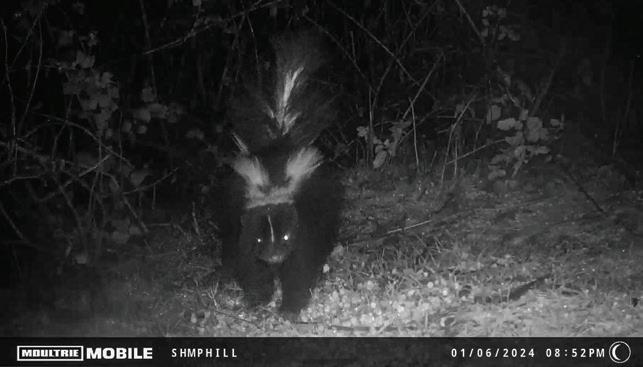
even daily hunting trips, the skunk bucket usually goes with me.
I RAISE THIS IN part because I’ve never seen as many skunks as I have in the past few years. From roadkills to picking them up on many of the trail cameras I run to encountering them on various hunts, they’re simply thick. No longer do I let the dogs run ahead of me in the dark to reach the duck blind. When letting them out for potty right before bed, we turn on the lights for a few minutes, go outside and holler to scare away skunks, then keep the dogs within sight to do their business. When skunks are prevalent in the back fields at night, we take the dogs out on a long lead.
By being prepared, you can get most of the skunk odor out of your pup. But we’ve not found nor have we talked to anyone who has a 100-percent-effective skunk deodorizer. The longer you wait to wash your dog, the harder it is to remove the smell. It’s just all part of being a gun dog owner. CS
Editor’s note: Watch Scott Haugen’s basic puppy training videos and learn more about his many books at scotthaugen.com. Follow his adventures on Instagram and Facebook.













